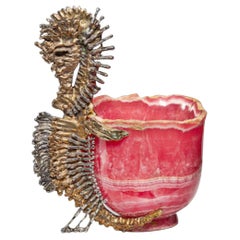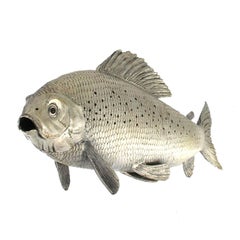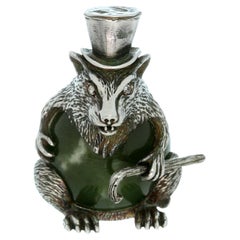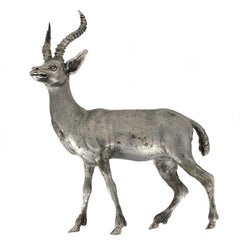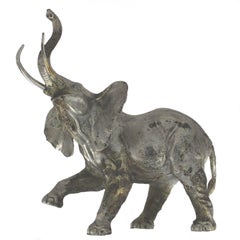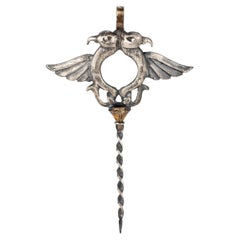Silver Figurines and Sculptures
to
18
89
51
33
31
22
6
4
4
3
2
8
15
81
56
4
1
2
5
16
11
1
3
83
6
8
3
1
1
1
to
10
9
4
3
3
10
7
7
5
3
2
2
1
1
1
87
2
48
27
Metal: Silver
Period: 20th Century
Period: 18th Century and Earlier
Chaumet Paris, a French Silver-Gilt Seahorse Mounted Rhodochrosite Cup
By Chaumet
Located in New York, NY
Chaumet Paris, A French Silver-Gilt Seahorse Mounted Rhodochrosite cup
Circa 1980.
An exceptional object
A quadrangular cut cup in rhodochrosite and the handle made of a seahorse ...
Category
20th Century French Silver Figurines and Sculptures
Materials
Rhodocrosite, Silver
Silver Fish Grayling handicraft
Located in Milano, Lombardia
Silver fish grayling handicraft
Category
1980s Italian Early Victorian Vintage Silver Figurines and Sculptures
Materials
Silver
Russian Antique Imperial Nephrite Sterling Silver Rat Sculpture
Located in New York, NY
This exquisite Russian Imperial sculpture features a rat in a top hat with a movable cane crafted out of sterling silver and nephrite. The nephrite is medium to medium light muddy gr...
Category
Early 1900s Antique Silver Figurines and Sculptures
Materials
Sterling Silver
Silver Gazelle handicraft
Located in Milano, Lombardia
Silver Gazelle handicraft
Category
1980s Italian Early Victorian Vintage Silver Figurines and Sculptures
Materials
Silver
Elephant handicraft in Silver
Located in Milano, Lombardia
Elephant handicraft in silver
Category
1980s Italian Early Victorian Vintage Silver Figurines and Sculptures
Materials
Silver
igar Piercer with Double-Headed Eagle – Bronze & Silver Sculptural Tool
Located in ISTANBUL, TR
Crafted for collectors of symbolism and fine craftsmanship, this sculptural cigar piercer features a majestic double-headed eagle—an emblem of power, protection, and dominion across ...
Category
16th Century Art Nouveau Antique Silver Figurines and Sculptures
Materials
Silver, Bronze
Vintage S. Kirk & Son Sterling Silver Miniature Owl Figurine
Located in Philadelphia, PA
By Samuel Kirk & Son.
In sterling silver.
In the form of an owl standing on the edge of a stump.
Marked to the base for for S. Kirk & Son / Sterling.
Simply a wonderful diminutiv...
Category
20th Century American Silver Figurines and Sculptures
Materials
Sterling Silver
Dog Sculpture Poodle in Silver
Located in Milano, Lombardia
Dog sculpture poodle in silver
Category
1980s Italian Early Victorian Vintage Silver Figurines and Sculptures
Materials
Silver
925 Silver Cigar Piercer – Handcrafted Cobra Head Design in Bronze and Silver
Located in ISTANBUL, TR
Striking and symbolic, this artisan-made cigar piercer features a sculptural cobra head, masterfully cast in bronze. The cobra—a symbol of power, transformation, and wisdom—lends thi...
Category
16th Century Art Nouveau Antique Silver Figurines and Sculptures
Materials
Pearl, Silver, Bronze
Antique Late 18th Century Cameo of a Follower of Dyonisos or Bacchus Hardstone
Located in Munich, Bavaria
This fine hardstone cameo depicts a woman or men wearing a wreath of ivy. In Greek and Roman mythology the ivy wreath worn around head was the attribute of a followers of Dyonisos a...
Category
1790s Italian Artist Antique Silver Figurines and Sculptures
Materials
Quartz, Silver
Vintage Gabriella Binazzi Italian Silvered Ostrich Egg Sea Lion Sculpture
Located in Perry, FL
Gabriella Binazzi Italian silvered ostrich egg sea lion scultpure featuring a naturalistic ostrich egg mounted with silvered brass legs, fin and head. St...
Category
1970s Vintage Silver Figurines and Sculptures
Materials
Silver
Caraffa in Argento Italiano XX Secolo
Located in Milano, IT
Caraffa sbalzata e incisa a mano in argento 800 nella metà del XX secolo, prodotta a Palermo Sicilia Italia. Misura 41x24x15xcm / 16.141x9.448x5.905 inches e pesa 993 grammi. Ha il m...
Category
Mid-20th Century Italian Retro Silver Figurines and Sculptures
Materials
Silver
Antique 18th Century Button Cameo of a Young Man Shell Carving Silver
Located in Munich, Bavaria
This rare button features a shell cameo of a young man carved in antique manner. The cameo is mounted in a silver button.
Category
1780s European George III Antique Silver Figurines and Sculptures
Materials
Silver
Jade Plaque Inscribed with Poem, 1900
Located in Southbury, CT
This dark green (almost black) nephrite jade pendant is inscribed with a brief poem about spring. The text — 泛好 红时春 万辰 风 象翠沐 新绿 雨 — which would appear to be an ode to the cleansing, ...
Category
Early 1900s Chinese Art Nouveau Antique Silver Figurines and Sculptures
Materials
Jade, Silver, Copper
Sterling Silver Stirrup Cup Wine Glasses 'Vermeil Inside' Depicting a Dog
Located in Roma, IT
This dog is one of 12 sterling silver "stirrup" glasses, vermeil inside, whose models date back to around the mid-1900s, and represent 12 animals that can be placed at the table to serve wine.
Most popular in the late 18th and 19th century, antique silver stirrup cups...
Category
1940s Italian Vintage Silver Figurines and Sculptures
Materials
Vermeil, Sterling Silver
Solid Silver Buffalo Figurine Vintage 1970s Made in Italy
Located in Milano, IT
Solid silver buffalo figurine very good vintage condition.
Dimensions: Height 24 mm / 0.944 inches - Length 50 mm / 1.968 inches - Weight 27 grams.
It is stamped with the Silver Ita...
Category
1970s Italian Retro Vintage Silver Figurines and Sculptures
Materials
Silver
Mid to Late 20th Century Silver and Gold Plate Belt Buckle with Tibetan Motif
Located in Point Richmond, CA
Mid to Late 20th Century Silver and Gold Plate Belt Buckle with Tibetan Motif
A round medallion shaped belt buckle with a carved whimsical dragon in a field of clouds, surrounding l...
Category
Mid-20th Century Nepalese Artisan Silver Figurines and Sculptures
Materials
Lapis Lazuli, Silver, Gold Plate
Dutch Silver Bench and Chair Miniatures for a Doll's House, Schoonhoven, 1970s
Located in St. Catharines, ON
Dutch Silver Bench and Chair Miniatures for a Doll's House, Schoonhoven, 1970s
Two Beautiful Dutch silver miniatures comprising a classic ladder back bench...
Category
1970s Dutch Vintage Silver Figurines and Sculptures
Materials
Silver
Male Doberman Dog Sculpture in Silver
Located in Milano, Lombardia
Male Doberman dog sculpture in Silver
Category
1980s Italian Early Victorian Vintage Silver Figurines and Sculptures
Materials
Silver
Pair of 800 Silver Miniatures Musical Instruments
Located in Montreal, QC
Pair of 800 silver gilt miniatures of musical instruments standing on hard stone. Stamped 800 Milano, measures 2 1/2 inches tall, in good vintage condition.
Category
1960s Italian Vintage Silver Figurines and Sculptures
Materials
Silver
French 1798 Neo Classic Stamp Seal in 18kt Gilded Silver with Carved Bust Flora
Located in Miami, FL
French neo classic desk seal.
Wonderful desk seal, created in France during the late 18th century, back in the 1798-1808. This magnificent piece of art was conceived as a miniature sculpture mounted in a Louis XVI neoclassical style base. This base is crafted in 18 karats gold over silver with chiseled and incised decorations, supporting a magnificent extremely detailed carving of a women. The carved piece, depicts, the naked portrait bust of the classical Greek-Roman goddess of the flowers and nature Flora (Heba), facing forward and exhibiting her breasts, undressed and crowned with flowers, wheat and ivy.
Flora or Heba
She was the deity of the flowering plants, fertility, spring, and blossoming. Although she was a minor figure compared to other goddesses of the Roman empire, she was important as a fertility goddess. Flora was responsible for the abundance of the crops in spring, so her worship strengthened as this season approached. Her name derives from the Latin floris, which means flower, and her Greek counterpart was the nymph, Chloris. The Sabine King Titus Tatius introduced Flora into the Roman pantheon...
Category
1790s French Neoclassical Antique Silver Figurines and Sculptures
Materials
Gold, 18k Gold, Silver
Antique Adie & Lovekin Ltd Birmingham c1906 Silver Ballroom Shoe Pin Cushion
Located in MELBOURNE, AU
Crafted with meticulous attention to details,
this Antique English Sewing Cushion Pin is absolutely delightful,
beautifully designed as a Ballroom Shoe
with curved buckle Edwardia...
Category
Early 1900s English Edwardian Antique Silver Figurines and Sculptures
Materials
Silver
1911 Delaunay-Belleville Sterling Silver Miniature Car
Located in Montreal, QC
Franklin Mint 1911 Delaunay-Belleville sterling silver miniature car with box. Measures 4 3/4 inches long x 2 1/4 inches tall 1 1/2 inches wide. Made in ...
Category
1970s American Vintage Silver Figurines and Sculptures
Materials
Silver
Silver Wild Bison Sculpture
Located in Milano, Lombardia
Silver Wild bison Sculpture
Category
1980s Italian Early Victorian Vintage Silver Figurines and Sculptures
Materials
Silver
Elephant Puppy Sculpture in Silver
Located in Milano, Lombardia
Elephant Puppy sculpture in silver
Category
1980s Italian Early Victorian Vintage Silver Figurines and Sculptures
Materials
Silver
Rare Pair of Important New York Estate English Silver White Jade Candlesticks
Located in New York, NY
The Following Item we are Offering is a Lovely Museum Quality Large and very elaborately openwork carved in an Exceptional even White Stone. Beautifully carved as a standing figure o...
Category
20th Century Silver Figurines and Sculptures
Materials
Jade, Silver
Silver Hound Bracco handicraft
Located in Milano, Lombardia
Silver hound bracco handicraft
Category
1980s Italian Early Victorian Vintage Silver Figurines and Sculptures
Materials
Silver
Pineapple Handicraft in Silver
Located in Milano, Lombardia
Pineapple handicraft in silver
Category
1980s Italian Early Victorian Vintage Silver Figurines and Sculptures
Materials
Silver
Antique Silver Belle with Figural Fowl-Bearing Countryman Handle
Located in New York, NY
Turn-of-the-century European silver bell. Tulip-bowl with twisted gadrooning. Figural handle depicting an old-fashioned countryman holding two live fowl. Here’s dinner—eventually. Su...
Category
Early 20th Century Unknown Edwardian Silver Figurines and Sculptures
Materials
Silver
Mellerio Paris, French Gold, Diamonds, Silver, Lapis, and Obsidian Polo Player
Located in New York, NY
Mellerio Paris, A French Gold, Diamonds, Silver-Gilt, Rock Crystal, Enamel, Emerald, Lapis Lazuli, Agate, Emerald, and Obsidian Polo Player, Carved Horse Sculpture, Jeweled Mounted Object.
An extremely rare and unique, one of a kind French Carved Horse Sculpture, Jeweled Mounted Object sculpture "CHEVAUX DE LEGENDE", "A Legendary Horse" by Mellerio, Paris, circa 1999.
Sitting on black obsidian base, the solid rock-crystal slab is finely applied with a carved obdisian hardstone horse and polo player, mounted in 18k gold, brilliant -cut diamonds, emaralds, enamel, lapis lazuli, and agate, .The obsidian base with a plaque engraved: CHEVAUX DE LEGENDE" / MELLERIO DITS MELLER PARIS / 5003 DIV
The piece is in excellent condition and comes with a custom made wood case made for transport. It's very elegant and has French hallmarks throughout. A truly magnificent piece.
Measures 12" high x 8" wide x 4" deep
Founded in France in 1613 by the descendants of Italian immigrants from the Vigezzo Valley in the north of Italy, Mellerio is one of the oldest jewellery houses in Europe. The family business soon attracted the attention of the Royal Court and Marie Antoinette herself reportedly purchased a precious bracelet featuring 7 cameos surrounded by rubies in 1780. Later on, in the 19th century, Mellerio became the official supplier of the French Royal family and the Court of Netherland.
Mellerio creates many jewellery items, all set with rare gems such as peridots, amethysts, aquamarines, citrines and topaz, applying for a patent, the flexible stem, a very supple and light jewellery mechanism. Mellerio remains also well known for their spectacular series of Art Nouveau jewels, created at the beginning of the 20th century, as well as for the creation of trophies rewarding some of the greatest footfall and tennis players of history. In 1993, the jewellery house launched their first watch collection.
Today, Mellerio has stores in Paris, Japan and Hong Kong.
July 14, 1789: this date is known throughout the world as the beginning of the French Revolution. According to a ledger belonging to House of Mellerio, this was also the day that the jeweler sold a golden key to the Comte de Coutance for 10 livres. This ledger, as well as inventories dating as far back as 1768, are the jeweler’s oldest archives. These archives have continued to grow over the years, as the House, established on rue de la Paix in Paris, still lives on today, still in the hands of the same family from Craveggia, in the North of Italy.
The tumultuous history of the Mellerio family in France probably goes as far back as the Italian wars of the Renaissance, but the first official document proving their commercial activity in Paris dates back to 1613. This document is the famous royal warrant awarded by Marie de Medici to a number of Italian families established along the rue des Lombards, including the Mellerios, allowing them to sell “small jewelery items”, therefore granting them a small exception to the traditional monopoly enjoyed by Parisian jewelers. At that time, powerful corporations regulated the operations and customs of Parisian business, but thanks to this exceptional warrant, the Mellerios managed to escape the confines of this framework. Today, this wax-sealed document is kept at the city hall of Craveggia.
From 1613 to the Revolution, the Mellerios lived between France and Italy. The corporations tried many times to put an end to their trade privileges, but all in vain, as a dynasty of sovereigns renewed the warrant. Always marrying and often retiring in Craveggia, the Mellerios continued to maintain their jewelry business in Paris. At first, they did this without a shop. Wearing backpacks (wooden boxes divided into small compartments where jewels were kept), they would tour town fairs around Paris and royal castles.
This is how Jean-Baptiste Mellerio (1765-1850) is said to have sold a bracelet set with rubies and Antique cameos to Marie-Antoinette, which still exists today. Many elements seem to prove the veracity of this anecdote. The queen was particularly fond of cameos, which cover the entire background of her famous jewelry cabinet, and ruby was her favorite stone after diamond. The famous bracelet, reacquired a few years ago by the House of Mellerio, is indeed an 18th century jewel, set with antique cameos representing the profiles of Roman emperors. Two branches of the family were operating in Paris during this time, under the reign of Louis XVI: that of Jean-François (1746-1828), the paternal ancestor of the current Mellerios, and that of Jean-Baptiste (1765-1850).
The French Revolution forced them to return to Italy. However, both Jean-Baptiste and François Mellerio (1772-1843), who was the son of Jean-François, were eventually able to return to Paris after the founding of the Consulate. Jean-Baptiste opened a shop at the Iron Crown of rue Vivienne, and François opened his at the Palais des Tuileries, rue du Coq Saint-Honoré. His well-organized order books give an idea of his high-ranking clientele during the “Old Regime”, among which were the Comte and Comtesse Octave de Segur, the Marquise (later Duchess) de Tourzel, former governess of the royal children, and her daughter, the Comtesse de Bearn, the Craufurds -who organized the flight to Varennes, the Duc and Duchess de Gramont, the Comtesse de Boigne, and Madame de Souza, Talleyrand’s mistress.
We also see the names of the imperial family: Empress Josephine, the Queen of Holland, Princess Elisa, Caroline and Pauline. At that time, the House of Mellerio specialized, among other things, in the trade of antique cameos, a newly fashionable genre of jewel that captured the imagination of all the princesses and noble women of the time.
The years of the Restauration and July Monarchy were among the most glorious. The Bourbons were back on the throne, and the clientele of the House of Mellerio had regained its former wealth. Mellerio supplied Louis-Philippe, Duke of Orléans, as well as his mother, wife and sister, with sumptuous jewels, including a set of emeralds made piece by piece, while the Duke of Bourbon, last prince of the House of Condé, offered diamonds to his mistress, the scheming Baronne de Feucheres, and Monsieur de LaFayette also bought cameos for one of his granddaughters. For the first time, Mellerio ventured into the world of arts in 1815, when Carlotta Grisi, a famous dancer who created Giselle, as well as an actress named Rachel, bought jewels at the Mellerio store on rue de la Paix.
1848 marked a new turning point. France once again became a Republic. François Mellerio handed the company over to his son, Jean, and the latter decided to travel to Spain to build a new clientele. He later became one of the jewelers of the royal family, and met Eugénie de Montijo, who remained a faithful client when she became empress of the French people. The Imperial years were lavish. During the Second Empire, Paris was a pageant of crinoline dresses designed by Worth, while jewels by Mellerio, Worth’s neighbour on the rue de la Paix, adorned the noble women of the Tuileries court.
The Empress bought pearls. Mathilde Bonaparte...
Category
20th Century French Art Deco Silver Figurines and Sculptures
Materials
Agate, Diamond, Emerald, Rock Crystal, Gold, Silver
Mellerio Paris, a French Gold, Diamonds, Silver, and Smoky Quartz Carved Horse
Located in New York, NY
Mellerio Paris, A French Gold, Diamonds, Silver-Gilt, Rock-Crystal, Jade, Mother-Of-Pearl and Smoky Quartz, Carved Horse Sculpture, Jeweled Mounted Object.
An extremely rare and unique, one of a kind French gold, diamonds, Silver-gilt, rock-crystal, jade, obsidian, mother-of-pearl, and smoky quartz carved jeweled sculpture "CHEVAUX DE LEGENDE", "A Legendary Horse" by Mellerio, Paris, circa 1991.
Sitting on black obsidian base, the solid rock-crystal slab is finely applied with a carved smoky -quartz and jade horse with a harness mounted in 18k gold, brilliant -cut diamonds, rubies, turquoise, and amethyst chains and pendants. The top columns adorned with 18k gold and brilliant cut diamond pendants, the bottom with gold and mother of pearl plaques. The obsidian base with a plaque engraved: CHEVAUX DE LEGENDE" / N° 05 / MELLERIO DITS MELLER / PARIS / 5003 D
The piece is in excellent condition and comes with a custom made wood case made for transport. It's very elegant and has French hallmarks throughout. A truly magnificent piece.
Measures 10.5" high x 8.5" wide x 4" deep
Founded in France in 1613 by the descendants of Italian immigrants from the Vigezzo Valley in the north of Italy, Mellerio is one of the oldest jewellery houses in Europe. The family business soon attracted the attention of the Royal Court and Marie Antoinette herself reportedly purchased a precious bracelet featuring 7 cameos surrounded by rubies in 1780. Later on, in the 19th century, Mellerio became the official supplier of the French Royal family and the Court of Netherland.
Mellerio creates many jewellery items, all set with rare gems such as peridots, amethysts, aquamarines, citrines and topaz, applying for a patent, the flexible stem, a very supple and light jewellery mechanism. Mellerio remains also well known for their spectacular series of Art Nouveau jewels, created at the beginning of the 20th century, as well as for the creation of trophies rewarding some of the greatest footfall and tennis players of history. In 1993, the jewellery house launched their first watch collection.
Today, Mellerio has stores in Paris, Japan and Hong Kong.
July 14, 1789: this date is known throughout the world as the beginning of the French Revolution. According to a ledger belonging to House of Mellerio, this was also the day that the jeweler sold a golden key to the Comte de Coutance for 10 livres. This ledger, as well as inventories dating as far back as 1768, are the jeweler’s oldest archives. These archives have continued to grow over the years, as the House, established on rue de la Paix in Paris, still lives on today, still in the hands of the same family from Craveggia, in the North of Italy.
The tumultuous history of the Mellerio family in France probably goes as far back as the Italian wars of the Renaissance, but the first official document proving their commercial activity in Paris dates back to 1613. This document is the famous royal warrant awarded by Marie de Medici to a number of Italian families established along the rue des Lombards, including the Mellerios, allowing them to sell “small jewelery items”, therefore granting them a small exception to the traditional monopoly enjoyed by Parisian jewelers. At that time, powerful corporations regulated the operations and customs of Parisian business, but thanks to this exceptional warrant, the Mellerios managed to escape the confines of this framework. Today, this wax-sealed document is kept at the city hall of Craveggia.
From 1613 to the Revolution, the Mellerios lived between France and Italy. The corporations tried many times to put an end to their trade privileges, but all in vain, as a dynasty of sovereigns renewed the warrant. Always marrying and often retiring in Craveggia, the Mellerios continued to maintain their jewelry business in Paris. At first, they did this without a shop. Wearing backpacks (wooden boxes divided into small compartments where jewels were kept), they would tour town fairs around Paris and royal castles.
This is how Jean-Baptiste Mellerio (1765-1850) is said to have sold a bracelet set with rubies and Antique cameos to Marie-Antoinette, which still exists today. Many elements seem to prove the veracity of this anecdote. The queen was particularly fond of cameos, which cover the entire background of her famous jewelry cabinet, and ruby was her favorite stone after diamond. The famous bracelet, reacquired a few years ago by the House of Mellerio, is indeed an 18th century jewel, set with antique cameos representing the profiles of Roman emperors. Two branches of the family were operating in Paris during this time, under the reign of Louis XVI: that of Jean-François (1746-1828), the paternal ancestor of the current Mellerios, and that of Jean-Baptiste (1765-1850).
The French Revolution forced them to return to Italy. However, both Jean-Baptiste and François Mellerio (1772-1843), who was the son of Jean-François, were eventually able to return to Paris after the founding of the Consulate. Jean-Baptiste opened a shop at the Iron Crown of rue Vivienne, and François opened his at the Palais des Tuileries, rue du Coq Saint-Honoré. His well-organized order books give an idea of his high-ranking clientele during the “Old Regime”, among which were the Comte and Comtesse Octave de Segur, the Marquise (later Duchess) de Tourzel, former governess of the royal children, and her daughter, the Comtesse de Bearn, the Craufurds -who organized the flight to Varennes, the Duc and Duchess de Gramont, the Comtesse de Boigne, and Madame de Souza, Talleyrand’s mistress.
We also see the names of the imperial family: Empress Josephine, the Queen of Holland, Princess Elisa, Caroline and Pauline. At that time, the House of Mellerio specialized, among other things, in the trade of antique cameos, a newly fashionable genre of jewel that captured the imagination of all the princesses and noble women of the time.
The years of the Restauration and July Monarchy were among the most glorious. The Bourbons were back on the throne, and the clientele of the House of Mellerio had regained its former wealth. Mellerio supplied Louis-Philippe, Duke of Orléans, as well as his mother, wife and sister, with sumptuous jewels, including a set of emeralds made piece by piece, while the Duke of Bourbon, last prince of the House of Condé, offered diamonds to his mistress, the scheming Baronne de Feucheres, and Monsieur de LaFayette also bought cameos for one of his granddaughters. For the first time, Mellerio ventured into the world of arts in 1815, when Carlotta Grisi, a famous dancer who created Giselle, as well as an actress named Rachel, bought jewels at the Mellerio store on rue de la Paix.
1848 marked a new turning point. France once again became a Republic. François Mellerio handed the company over to his son, Jean, and the latter decided to travel to Spain to build a new clientele. He later became one of the jewelers of the royal family, and met Eugénie de Montijo, who remained a faithful client when she became empress of the French people. The Imperial years were lavish. During the Second Empire, Paris was a pageant of crinoline dresses designed by Worth, while jewels by Mellerio, Worth’s neighbour on the rue de la Paix, adorned the noble women of the Tuileries court.
The Empress bought pearls. Mathilde Bonaparte...
Category
20th Century French Silver Figurines and Sculptures
Materials
Amethyst, Diamond, Jade, Quartz, Rock Crystal, Ruby, Turquoise, Gold, Si...
